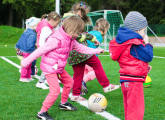Helping children to develop the dexterity and strength of their fingers and thumbs needn’t be dull, says Kirstine Beeley…
Fine motor skills – the cornerstone of so many things we expect young children to be able to do, from getting dressed and undressed, to feeding, using scissors and moving and handling everyday objects.
Of course, strength in little fingers (and toes), wrists and hands is important for controlling pencils in time, but it’s worth remembering that writing is only a tiny part of what children need to be independent and confident in their lives.
Here I’ve gathered together a selection of simple and engaging activities that build on fine motor development as part of children’s ongoing play, with the aim of building awareness of the underlying action or skill involved.
Fine motor skills can broadly be divided into four categories: to build strength in hands and wrists children need to practise squeezing, pinching and twisting, as well as their hand-eye coordination – they need to train not only their bodies but the links between body and brain.
These activities will help children to build strength and coordination…
Tennis ball buddies
Slit a tennis ball, add googly eyes, a nose and hair. Squeeze your ball buddy to open his mouth and feed him counters, pompoms or water beads for hours of fun.
The smaller the mouth slit, the harder children must squeeze the ball to open the mouth.
Squirty bottles
Outdoors isn’t just about gross motor development! Introduce a wide range of squirty bottles and containers to build up hand muscles.
Add targets to floors and walls for lots of pump-action exploration. Add paint to bottles and water pistols for squirty creativity with a fine motor twist.
Spaghetti scissors
Before children can control a pair of scissors to cut something out, which involves strength and coordination in both hands at the same time, they need a lot of opportunities to repeat and build their snipping skills.
Giving them access to lots of soft materials to snip builds the squeezing action and strength in hands. Try colouring spaghetti and adding scissors and superheroes for some fun cutting action.
Syringe painting
Exploring syringes of a wide variety of sizes helps children build their hand strength and coordination.
Add measuring syringes to coloured water play or fill them with watered-down paint to squirt some art. Fill with watery gloop (cornflour and water) or hair gel goo for a stiffer squeezing experience.
Clunk clips
Build up a collection of bulldog/stationery clips that children can clip to pots, string and paper to build hand muscles. Lots of different sizes and colours ensures an invitation to play that promotes strength and coordination development.
Pinching is an action key to so many everyday skills.
Zipping up coats, doing up laces, buttoning shirts, opening tin cans and packets, sewing, holding cutlery and, of course, holding a pen all involve a pinching action and require the development of both strength and coordination.
Podding peas
This is a fun way to combine fine motor development with exploration of the natural world: try podding peas or beans. Once podded, moving them into small pots and containers again builds on that essential pinching action.
Cotton bud painting
Get creative and physical at the same time! Introducing tiny tools to your creation area will help promote fine motor pinching, and the spotty paintings you can create with cotton buds are great for introducing the work of artists such as Georges Seurat and Paul Signac.
Geoboards
There are many ready-made geoboards on the market that give hours of elastic band shape exploration whilst using and developing the pinching action in little hands.
Why not try to make your own with log slices and nails for a more natural, outdoor feel?
Tongs and waterbeads
Handling waterbeads (available on eBay and Amazon as well as scrap stores around the country) in general helps promote fine motor development.
Add them to water play or shaving foam and encourage children to pick them out using finger and thumb movements. Add sugar tongs and bath mat shapes and the invitation to squeeze and pinch becomes irresistible.
A skill essential to everyday survival in this world of packets, jars, buttons and knobs, twisting is a fine motor skill that is often overlooked…
Wind-up toys
Build a collection of inexpensive wind-up toys; they will build up that twisting strength and action and provide children with a great reward as the toy unwinds.
Nuts and bolts
Children love to tinker, so providing a tray of nuts, bolts and washers in a variety of sizes always proves popular and promotes ‘twisting’ whilst providing lots of creative design fun.
Add metal cutlery holders with holes for children to thread the bolts through before twisting on the nuts and washers.
Bottles and jars
A really simple but highly engaging and effective activity is to provide a basket full of small jars, bottles and containers and their corresponding lids for children to explore.
As well as the twisting motion, this activity encourages lots of size and shape sorting as part of their play.
Locks and keys
Keys and locks hold eternal curiosity for children. Building up a basket of different sizes and shapes is great for encouraging that twist action as well as the hand-eye coordination needed to put keys into locks.
Try taking this a step further by building your own lock board, where children can freely explore a wide range of locks and bolts for tiny fingers.
Spinning tops
Age-old fun for little fingers, spinning tops are great for developing twisting skills, and the large pump-action ones are good for building gross motor skills in shoulders and arms.
The possibilities for open-ended exploration on a tray are immense, especially if you add timers and stopwatches to the mix.
As I’ve already mentioned, fine motor skills require the development of both strength and coordination, so here are some activities that promote the latter…
Pumpkins and hammers
This fun seasonal activity involves pumpkins, golf tees and tiny hammers. Letting children hammer the tees into the pumpkins is brilliant for building hand-eye coordination.
Hint: tap tees into the pumpkins with a big hammer beforehand to provide guide holes – this allows children to use toy wooden hammers and still be able to get the tees into the pumpkins.
Out of pumpkin season, try using half a melon or a watermelon. Alternatively, hammer coloured matchsticks into play dough.
Threading
Threading is one of the most common fine motor activities, but with a little tweaking it can be given a new lease of life. Try threading beads onto stretched-out metal egg cups, or push spaghetti into foam for fun straw threading.
Curtain rings and cup stands
This is a heuristic play activity that builds on hand-eye coordination, as well as providing lots of sorting, matching and size talk.
Collect lots of wooden curtain rings in different sizes and colours. Use wooden cup trees to give children something to hang the rings on, and add a wooden kitchen roll holder to make a curtain ring sorting tower. This is great for really small children and babies.
Rice and sand
Using small containers and a range of messy play materials is great for building coordination. Try colouring some rice or sand for added excitement and engagement. Plastic shot glasses are ideal tiny containers and come in a range of bright colours and designs.
I can’t go without mentioning play dough. A staple of early years provision and a favourite with children, it can be made in a rainbow of colours and scents to stimulate the senses.
Whilst children play, encourage them to explore the full range of actions to build up hand and finger strength. Try squashing, squeezing, rolling (into balls and worms), cutting and pinching.
Kirstine Beeley is an independent trainer, author and consultant, with experience of teaching in early years, primary and SEN settings.

Raksha Bandhan – How to celebrate in Early Years
Editors picks

EYFS sports activities – Ideas to try at nursery
Editors picks
